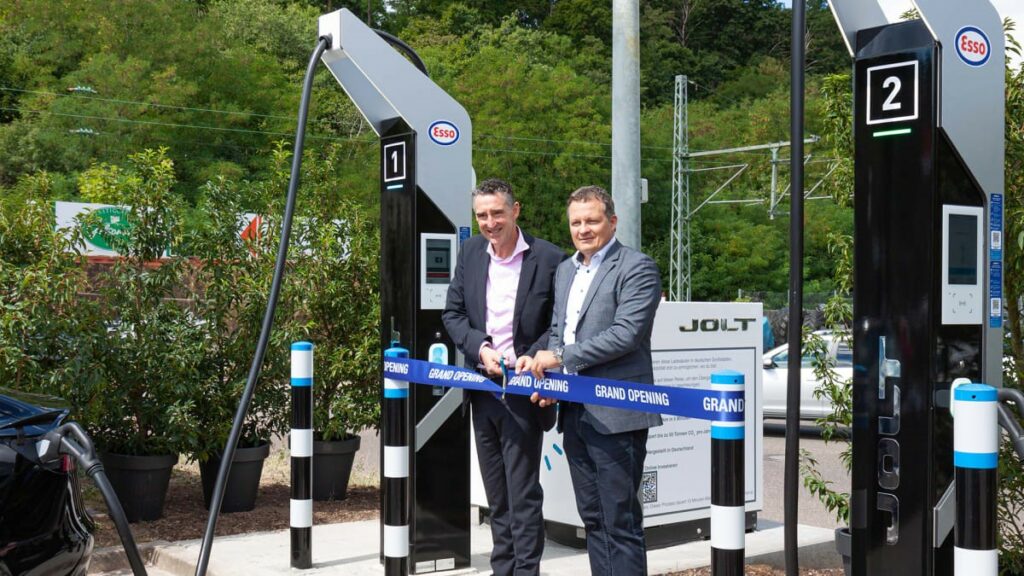
The German battery storage-integrated EV charging space had a busy July, with startup Numbat raising €10m-plus in capital and Volkswagen and JOLT Energy opening charging parks.
The adoption of electric vehicles (EVs) has accelerated dramatically in the last few years, an underestimation of which some have attributed as one of the main causes for the lithium supply chain bottlenecks blighting the energy storage sector.
Enjoy 12 months of exclusive analysis
- Regular insight and analysis of the industry’s biggest developments
- In-depth interviews with the industry’s leading figures
- Annual digital subscription to the PV Tech Power journal
- Discounts on Solar Media’s portfolio of events, in-person and virtual
Whilst clearly good news for the decarbonisation of the transport sector, the growth in EVs on the road places enormous additional demands on local grid infrastructure to accommodate new charging points. A lack thereof is one of the most common issues raised by consumers wanting to make the switch from ICE (internal combustion engine) vehicles.
Energy storage can play a huge role in solving these grid infrastructure bottlenecks by storing energy from the grid and providing the high-power output EVs need which the local grid cannot provide. Storage-integrated EV charge points can therefore be built anywhere with grid access, whereas standalone high-power EV chargers need access to higher-power grid connections.
Storage-integrated EV charging infrastructure is also quicker and cheaper to set up because of less exhaustive grid connection requirements, and avoids the possibility of peak demand charges from local grid operators.
Two years ago, research firm Guidehouse Insights estimated that stationary energy storage in support of electric vehicles (EVs) charging could reach a global installed capacity of 1,900MW by the end of 2029. The report, covered by Energy-Storage.news at the time, looked into residential, fleet, private, public and mobile charging.
Germany a hotbed of activity
Numbat, which was founded last year, has raised the new funds from eCAPITAL and seed investors including Christoph Ostermann, the founder and former CEO of residential storage group sonnen. It did not specify the amount but said it is in the ‘mid-double digit millions (of euros)’.
Numbat operates high-power chargers combined with battery energy storage reducing the requirements from local grid infrastructure during installation, which also increases the speed and simplicity of installation. The company is rolling out its first 50 locations in 2022 and plans 600 systems for 2023. It aims to be come the leading provider of fast charging infrastructure in Europe.
“With rising numbers of electric vehicles on the streets, we see a huge demand for high-power charging (HPC) infrastructure worldwide in many years to come. Numbat has developed an excellent concept to quickly roll-out HPCs at its customers locations with minimal cost by combining battery storage with high power charging,” says Bernd Arkenau, Managing Partner at eCAPITAL.
Earlier in July, automotive group Volkswagen commissioned a high-power EV charging park at its Zwickau, Saxony, vehicle plant, which is powered ‘largely’ by an energy storage unit with a capacity of 570kWh. All cell modules in the storage unit were taken from pre-production models of the company’s ID.3 and ID.4 compact EV.
Like Numbat, VW pointed out that the integration with a storage unit (power storage container in its vernacular) means it can be built in places with a low capacity grid connection. The high-power charging units, in this case 75-150kW, can therefore be built in those residential areas where previously only AC charging at a maximum of 11kW has been possible.
The charging park, made up of four stations each with a 150kW output that can be shared by two cars, is also powered by 100% renewable energy.
Volkswagen’s is the second high-profile announcement of a new battery storage-integrated EV charging park in the space of a week in Germany. An ‘ultra-fast, battery-buffered’ charging station has opened at an ESSO service station in Stuttgart, developed by JOLT Energy and ADS-TEC Energy.
JOLT Energy owns and operates ultra-fast charging solutions in urban areas while Nasdaq-listed ADS-TEC Energy develops battery storage solutions and EV charging systems. A press release did not provide details about the power rating of the charging station nor the size of the battery.
JOLT plans to rollout 5,000 EV charging stations using ADS-TEC’s solution in Europe and the USA by 2027. In the nearer term, it wants to install 120 at 60 ESSO locations in Germany in the next 6-8 months.

Storage-integrated EV charging groups outside Germany and outside batteries
The undeniable value proposition of integrated EV charging with energy storage means the technology solution is gaining traction globally.
As Energy-Storage.news reported in April, US-based FreeWire Technologies raised US$125 million in new capital from BlackRock and others to support the commercial rollout and increase manufacturing capacity for its battery storage-integrated charging solution. Its Boost Charger is integrated with an embedded 160kWh lithium-ion battery energy storage system (BESS).
The combination isn’t strictly limited to charging using batteries either. Israel-based company ZOOZ Power’s (formerly Chacratec) Kinetic Power Booster uses a flywheel energy storage system which integrates with its charging station. It says the storage system has a 15-year and 200,000 charge cycle lifetime.

